
The Swedish Coastal Artillery has its origin in the Archipelago Artillery that was raised in 1866. The Coastal Artillery was formed from the Archipelago Artillery, the Marine Regiment and parts of the Artillery in 1902. Kustartilleriet, abbreviated KA, was an independent branch within the Swedish Navy until July 1, 2000, when the Swedish Coastal Artillery was disbanded and reorganised as the Swedish Amphibious Corps. The changed name and new structure were to reflect the new tasks that the old Coastal Artillery had moved to after the end of the Cold War and the demise of the Warsaw Pact.

Fårösund is a locality situated on the Swedish island of Gotland with 800 inhabitants in 2014. The village can be reached by car from Visby. The island of Fårö can be reached by ferry from Fårösund.
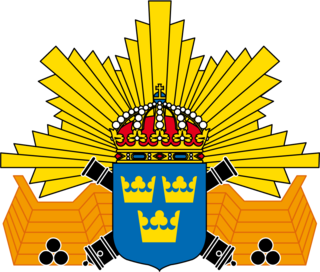
The Vaxholm Coastal Artillery Regiment, designation KA 1, was a Swedish Navy coastal artillery regiment of the Swedish Armed Forces which operated between 1902 and 2000. The unit was based at Rindö in the Stockholm archipelago in Uppland.
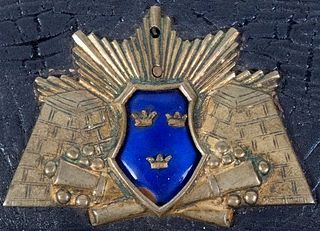
Vaxholm Artillery Corps was an artillery unit of the Swedish Army which operated between 1889 and 1901. The unit was based in Vaxholm in Uppland.
Vaxholm Grenadier Regiment, also I 26, was a Swedish Army infantry regiment that was active in various forms 1902–1927. The unit was based on Rindö in Vaxholm.
The Defence Act of 2000 was a defence act passed by the Swedish Riksdag on 30 March 2000, and the largest reorganisation of the Swedish Armed Forces since the Defence Act of 1925. The act was a continuation of the policies set in motion by the Defence Act of 1996: shifting the military's focus from the defence of Swedish territory to a more flexible "operational defence* for smaller-scale peacekeeping operations in foreign nations. Many military formations were disbanded as a result.

The Gotland Coastal Artillery Regiment, designation KA 3, was a Swedish Navy coastal artillery regiment of the Swedish Armed Forces which operated between 1937 and 2000. The unit was based in Fårösund in Gotland.
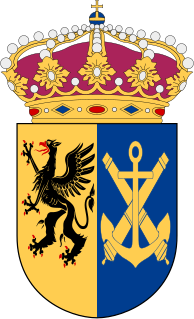
Södertörn Marine Regiment (Swedish: Södertörns marinregemente, designation SMR, was a Swedish Navy coastal artillery unit which operated from 1956 to 2000. The unit was based on Järflotta south of Nynäshamn.

Roslagen Marine Regiment (Swedish: Roslagens marinregemente, designation RMR, was a Swedish Navy coastal artillery unit which operated between from 1956 to 2000. The unit was based at Hamnholmen in Norrtälje Municipality.

The 1st Marine Regiment is an amphibian regiment of the Swedish Amphibious Corps based at the Berga Naval Base in Berga, Haninge Municipality. Raised from the Vaxholm Coastal Artillery Regiment in 2000 when the Swedish Amphibious Corps was formed, the 1st Marine Regiment has a large geographical spread where units are trained and grouped at Berga, south of Stockholm, in Gothenburg and in Gotland. Although the unit's natural combat environment is coastal zones, river deltas and other amphibious areas, the unit has the ability to operate in all types of terrain, such as desert. The 1st Marine Regiment has participated in operations in, for example, Kosovo, Gulf of Aden, Chad and Afghanistan.

The 4th Marine Regiment is an amphibian regiment of the Swedish Amphibious Corps based in Gothenburg. Raised from Älvsborg Coastal Artillery Regiment in 2000 when the Swedish Amphibious Corps was formed, the 4th Marine Regiment only operated for four years before being disbanded in 2004. The regiment was re-raised on 1 October 2021.
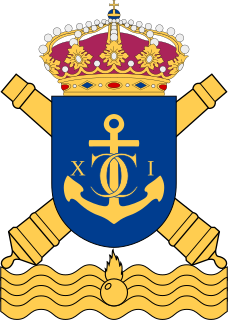
The Karlskrona Coastal Artillery Regiment, designation KA 2, was a Swedish Navy coastal artillery regiment of the Swedish Armed Forces which operated between 1902 and 2000. The unit was based in Karlskrona.

The Älvsborg Coastal Artillery Regiment, designation KA 4, was a Swedish Navy coastal artillery regiment of the Swedish Armed Forces which operated between 1942 and 2000. The unit was based in Gothenburg.
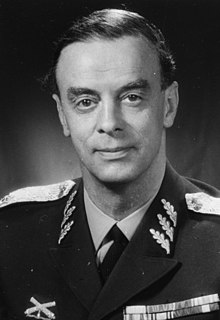
Lieutenant General Henrik Lange was a Swedish Coastal Artillery officer. Lange's senior commands include postings as Inspector of the Swedish Coastal Artillery, Chief of the Naval Staff and military commander of the Western Military District.

Gothenburg Coastal Artillery Defence was a unit of the Swedish Coastal Artillery which operated from 1942 to 1980. The staff was located in the Gothenburg Garrison in Gothenburg, Sweden.

The Härnösand Coastal Artillery Regiment, designation KA 5, was a Swedish Navy coastal artillery regiment of the Swedish Armed Forces which operated between 1943 and 1998. The unit was based in Härnösand.
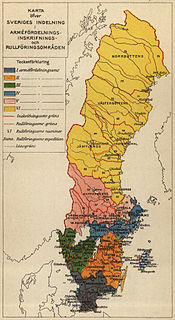
The military subdivisions of Sweden refers to the division of Sweden's territory with regard to the command possibilities, mainly in war. The subdivisions are different depending on Sweden's military doctrine. The subdivision can apply to both land and sea territory. On 1 January 2013, the Swedish Armed Forces re-established regional staffs, dividing the country into four military regions. A fifth military region was formed in 2019.
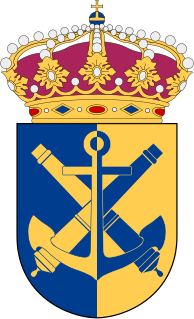
The West Coast Naval Command was a naval command within the Swedish Navy that operated in various forms in from 1928 to 2000. The unit was based in Gothenburg.

Lieutenant General Jakob Hjalmar Åström was a Swedish Coastal Artillery officer. Åström's senior commands include postings as commanding officer of the Karlskrona Coastal Artillery Regiment (1935–1941) and Inspector of the Swedish Coastal Artillery (1941–1953).

The Naval Base is a naval unit within the Swedish Navy that has operated in various forms since 1928. The unit is mainly based within Karlskrona naval base in Karlskrona and but operations are also conducted at Berga Naval Base and Muskö naval base outside Stockholm and in Gothenburg.